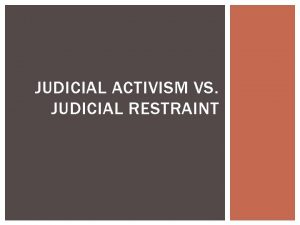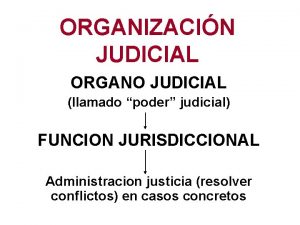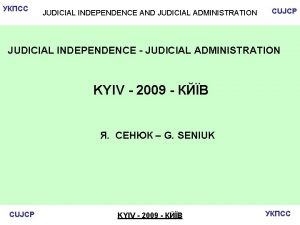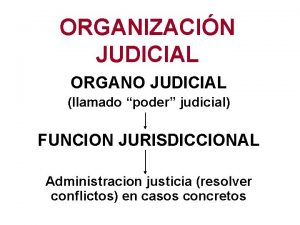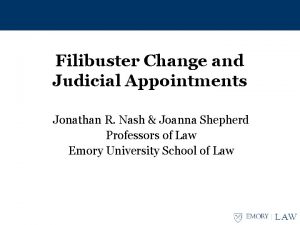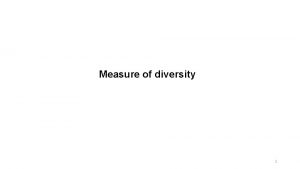Judicial Appointments Commission performance in improving judicial diversity























- Slides: 23

Judicial Appointments Commission performance in improving judicial diversity regarding women and BAME candidates: evidence pack June 2013

Key findings • There are significant limitations to the impact JAC can have on the diversity of the judiciary (slides 3 – 5). Despite that, diversity among the court judiciary has increased since the formation of the JAC (slides 6 – 8). • The diversity of recommendations made by the JAC is heavily influenced by the diversity of candidates who are eligible to apply for judicial posts. The recommendations made by the JAC reached or nearly reached the level of diversity of the pool of eligible candidates for four of the seven major court posts. The recommendations made to tribunal posts by the JAC are in line with or exceeded the level of diversity of the eligible pool (slides 9 – 12). • The diversity of recommendations to the court judiciary has been consistently higher since the formation of the JAC than it was prior to the formation of the JAC (slides 13 – 15). During the lifetime of the JAC the diversity of recommendations has increased for more than half of the seven major court posts, and there has also some increase in the proportion of recommended candidates who are women among the tribunal judiciary, but there is no clear trend in the proportion of tribunal judiciary who are BAME (slides 13, 16 – 18). • The difference between the diversity of the eligible pool and the judiciary in post is a measure of how much work there is left to do regarding improving judicial diversity. The court judiciary remains consistently less diverse than the pool of eligible candidates across both gender and ethnicity. By contrast, the level of diversity in the tribunal judiciary is virtually identical to the level of diversity in the pool of eligible candidates (slides 19 – 23). 2

Background In 2006, the Judicial Appointments Commission (JAC) was formed to maintain and strengthen judicial independence by taking responsibility for selecting candidates for judicial office out of the hands of the Lord Chancellor and making the appointments process clearer and more accountable. The first exercise conducted entirely under JAC processes was completed in March 2007. An important goal for the JAC has been to increase the diversity of those recommended to judicial posts to create a judiciary that is more representative of the general population, in the context of judicial selection on merit, through fair and open competition. This presentation will focus on the diversity of the judiciary regarding gender and ethnicity. Because the JAC has responsibility for judicial recruitment up to and including High Court level, this analysis will not cover any post more senior that than. Results from JAC recruitment exercises have been collected and aggregated. This data has been drawn from Official Statistics publications where available. Where the exercises pre-date Official Statistics they have been drawn from internal management information from the Equitas database. Evidence is presented on the effectiveness of the JAC in increasing judicial diversity against different standards along which performance can be measured. Recommendations regarding court judiciary relate to the period between March 2007 and September 2012; recommendations regarding tribunal judiciary relate to the period between March 2007 and March 2012. 3

Candidates recommended by the JAC make up around 1/3 of the total judiciary in post The number of recommendations made by the JAC since its formation in legal posts is just over one-third of the total judiciary in post. Please note that the total number of individuals recommended by the JAC will be less than this, as some individuals will have been recommended more than once if they have moved post. This limits the impact the JAC can have on judicial diversity, as the majority of the judiciary in post were recruited prior to the existence of the JAC. 4

The pool of people who are eligible to apply for judicial posts is not representative of the wider population The JAC has a legal responsibility to appoint on merit. Assuming that merit is distributed evenly around the pool of candidates who are eligible to apply for judicial posts, the diversity of recommendations made by the JAC is heavily influenced by the diversity of candidates who are eligible to apply for judicial posts. The diversity of the pool of candidates who are eligible to apply for judicial posts is shown in the figure above, and is not representative of the wider population by gender or ethnicity. This imposes a significant limitation on the ability of the JAC to improve the diversity of the judiciary. 5

Standards against which to measure performance (impact upon the judiciary) The diversity of the judiciary is a function of the cohort entering the judiciary following a recommendation by the JAC. But it is also effected by the profile of the existing judiciary, as well as the diversity of those leaving the judiciary, either because of retirement or for some other reason. If the judiciary is becoming more diverse this means the recommendations made by the JAC are contributing to that change in diversity, despite the limitations highlighted in the previous section. The data is taken from the Judicial Office archived statistics. 6

Among court judiciary, the proportion of women rose between 2007 and 2012 among all seven posts The proportion of court judiciary who are women has risen steadily during the lifetime of the JAC among all seven court posts. The largest increases of six percentage points were among High Court Judges and Circuit Judges. (The High Court result is based on relatively low numbers and should be treated with caution: 10 out of 108 judges in 2007 and 17 out of 110 in 2012). The lowest increase, of one percentage point, was among Recorders. 7

Among court judiciary, the proportion of BAME rose between 2007 and 2012 for 5 out of 7 posts The proportion of court judiciary from a BAME background rose most for High Court Judge by four percentage points (from one out of 108 judges in 2007 to five out of 110 judges in 2012) and District Judge (civil) with an increase of 2 percentage points. It fell for District Judge (mags’) by two percentage points and DDJ (mags’) by one percentage point. 8

Standards against which to measure performance (eligibility) Assuming that merit is distributed evenly around the pool of candidates who are eligible to apply for judicial posts, the diversity of recommendations made by the JAC is heavily influenced by the diversity of candidates who are eligible to apply for judicial posts. The eligibility criteria for most fee-paid tribunal judge positions and Deputy District Judges (DDJ) is five or more years of experience as solicitor, barrister of legal executive. Data is collected from the Law Society, Bar Council and CILEX to measure the diversity of legal professionals with that level of experience. For Recorders: the requirement is generally seven years experience in the legal profession as solicitor, barrister. 40% of people with that experience are female and nine per cent are from a BAME background. For most salaried tribunal positions, District Judge (magistrates’ and civil), Circuit Judge and High Court Judge: the requirement is that the candidate must have judicial experience either at the fee-paid or salaried level. For Circuit Judge and High Court Judge in particular, these are the minimum eligibility criteria – to have a realistic chance of success the candidate usually has further judicial experiences than this. The full effect of the informal eligibility requirements surrounding the more senior posts cannot be properly modelled at present. The effect of the eligibility criteria is measured using the pool of eligible candidates. A brief description of how the eligible pool is calculated is provided in the Definitions and Measurements paper. All information comes from 2012 9

For 4 out of 7 court judicial posts, recommendations have a higher % of women than the pool of eligible candidates District Judge (mags) shows the greatest difference between the diversity of the pool and of recommendations with 43% of recommendations being women compared to an eligible pool of 29%. For High Court, the diversity of the pool is greater than of recommendations with 20% of recommendations (12 out of 61) being women compared to an eligible pool of 29%. 10

For 2 out of 7 court judicial posts, recommendations have a higher % of BAME candidates than the pool of eligible candidates. For 2 other posts the difference is less than 1 percentage point For two out of seven posts (DDJ mags and District Judge civil), recommendations have been more ethnically diverse than the pool of eligible candidates. For two other posts (DDJ civil and Recorders) the difference is less than one percentage point. 11

For tribunal judiciary overall, the proportion of recommendations that are women is higher than the eligible pool and the proportion that are BAME is in line with the pool For the overall tribunal judiciary, the proportion of recommendations that are women is slightly higher than the eligible pool (43 to 40%). The overall proportion of recommendations that are from a BAME background in line with the eligible pool (nine percent for both measures). Among fee-paid posts, the proportion of recommendations that are women or from a BAME background is slightly less than the eligible pool. Among salaried posts, the proportion is of recommendations that are women or from a BAME background is greater than the eligible pool. 12

Standards against which to measure performance (trend over time) A) Comparing the diversity of recommendations since the formation of the JAC with the period before the formation of the JAC: Data is available on the diversity of applications and recommendations for court-room judiciary since 1999 (for Recorders since 2002). This is from the 10 years trends research. This information can be compared to the results of exercises since the formation of the JAC. Data is not available on the diversity of tribunal posts prior to the formation of the JAC. This measures whether JAC recommendations have been more diverse compared to those made in the preceding period. B) Comparing the trend over time in the diversity of applications and recommendations during the lifetime of the JAC: This measures whether JAC recommendations have been getting more diverse since its formation. Please see Annex A of the June 2013 JAC diversity statistics bulletin for an analysis of the diversity trends of applications and recommendations made by the JAC. 13

For all seven court-room judicial posts, the proportion of recommendations that are women is higher than prior to the formation of the JAC * Recorder's pre-JAC recommendations are from 2002 -2006 The increase is more than 10 percentage points in four out of seven posts: Deputy District Judge (magistrates’ court), Recorder and District Judge (civil). 14

For all seven court judicial posts, the proportion of recommendations that are BAME is higher than prior to the formation of the JAC * Recorder's pre-JAC recommendations are from 2002 -2006 The increase is more than 10 percentage points in one post: Deputy District Judge (Magistrates’ court). For some of the posts, the results are based on low numbers and should be interpreted with caution e. g. for High Court one out of 55 recommendations was for a BAME candidate prior to the formation of the JAC, and two out of 61 were since the formation of the JAC. 15

The proportion of recommended candidates who are female has improved during the lifetime of the JAC in 4 out of 7 court posts To look at trends during the lifetime of the JAC, the proportion of recommendations that were women in the first (earliest) recruitment exercise the JAC conducted for a post can be compared with the equivalent proportion in the latest (most recent) exercise. Increases in the proportion of recommended female candidates have been particularly large among High Court Judges (from three out of 21 in the earliest exercise to two out of five in the latest) and District Judge (mags). The largest reductions in the proportion of recommended female candidates have been among Circuit Judges (although this was not a purely like-for-like comparison) and DDJ (civil). 16

The proportion of recommended candidates who are from a BAME background has improved during the lifetime of the JAC in 5 out of 7 court posts Increases in the proportion of recommended candidates from a BAME background have been particularly large among DDJ (Mags) and Circuit Judges. Among High Court Judges the earliest and latest recruitment exercises produced no recommended candidates from a BAME background, although an exercise in 2010/11 did so. The only post with a reduction in the proportion of recommendations from a BAME background was District Judge (mags). 17

The proportion of recommendations for tribunal judicial posts that are women has increased but the proportion that are BAME shows no clear trend In the first two years the proportion of recommended candidates who was female was just under one-third but since then has been just under one-half. The proportion of recommended candidates from a BAME background has not shown any clear pattern. 2007/08 and 2008/09 were merged due to the small number of tribunal recommendations made in 2007/08. Please note this analysis is not a like-for-like basis as the mix of posts that JAC has provided recommendations for may differ by year. For a summary of a like-for-like analysis please see Annex A of the June 2013 JAC diversity statistics bulletin. 18

Standards against which to measure performance (judiciary in post compared to the eligible pool) The long-term goal of the JAC is to increase the diversity of the judiciary so that it matches the diversity of the pool of people who meet the eligibility criteria for the different posts that constitute the judiciary. The difference between the diversity of the eligible pool and the judiciary in post is a measure of how much work there is left to do regarding improving judicial diversity. 19

The proportion of women in the eligible pool is higher than the proportion of women judges in the court judiciary in 2012 for 6/7 posts District Judge (mags) has the same proportion of women in post as in the pool and District Judge (civil) only a shows a three percentage point difference. The largest gap between the eligible pool and the proportion of women in the court judiciary is for Recorders (24 percentage points). The two other fee-paid posts also show a considerable gap as does High Court. 20

The proportion of BAME in the eligible pool is higher than the proportion of BAME judges in the court judiciary in 2012 for all posts The largest gap between the eligible pool and the proportion of BAME in the court judiciary is for the two DDJ posts (five - six percentage points). Recorders and Circuit Judge also show a considerable gap (four percentage points). District Judge (Civil) and High Court are closer in proportion to the pool. 21

The proportion of women in the eligible pool and of women judges in the overall tribunal judiciary in 2012 are virtually identical The proportion of fee-paid tribunal judiciary who are women is three percentage points less than among the eligible pool but is six points more among salaried tribunal judiciary. Looking at tribunal judiciary as a whole the proportion who are women is virtually identical to the proportion in the pool. 22

The proportion of BAME in the eligible pool and of BAME judges in the overall tribunal judiciary in 2012 are virtually identical The proportion of fee-paid tribunal judiciary from a BAME background is two percentage points less than in the eligible pool but is three percentage points more among salaried tribunal judiciary. Looking at tribunal judiciary as a whole the proportion who are from a BAME background is virtually identical to the proportion in the pool. 23
 Judicial restraint vs judicial activism
Judicial restraint vs judicial activism Judicial restraint examples
Judicial restraint examples Judicial activism vs judicial restraint
Judicial activism vs judicial restraint Judicial restraint vs judicial activism
Judicial restraint vs judicial activism Judicial activism v. judicial restraint
Judicial activism v. judicial restraint Improving own learning and performance examples
Improving own learning and performance examples Improving security performance
Improving security performance Jonathan washko
Jonathan washko Why is genetic diversity important
Why is genetic diversity important Genetic diversity vs species diversity
Genetic diversity vs species diversity Mudaliar commision
Mudaliar commision What is a graduated commission
What is a graduated commission Arizona judicial performance review
Arizona judicial performance review 10051 university blvd dmv
10051 university blvd dmv Fau academic probation
Fau academic probation Classification of table appointments
Classification of table appointments What are the two basic shapes of beverageware?
What are the two basic shapes of beverageware? How to schedule appointments with clients
How to schedule appointments with clients York hospital entrance 2
York hospital entrance 2 Visitors with appointments
Visitors with appointments Table appointments examples
Table appointments examples Harding made several distinguished appointments to his
Harding made several distinguished appointments to his Public appointments secretariat
Public appointments secretariat Tol registration
Tol registration
























